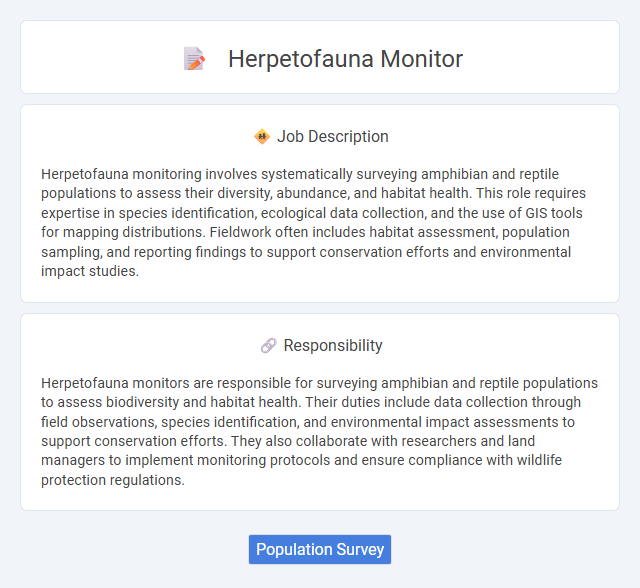
Herpetofauna monitoring involves systematically surveying amphibian and reptile populations to assess their diversity, abundance, and habitat health. This role requires expertise in species identification, ecological data collection, and the use of GIS tools for mapping distributions. Fieldwork often includes habitat assessment, population sampling, and reporting findings to support conservation efforts and environmental impact studies.
Individuals with a strong passion for wildlife and comfort with outdoor conditions may likely find herpetofauna monitoring jobs suitable. Those able to endure variable weather, navigate rough terrains, and work independently might be well-suited for this role. People with physical agility and patience for detailed observations could probably excel in this field.
Qualification
A Herpetofauna monitor requires a strong background in biology, particularly in herpetology, with a bachelor's degree in environmental science, wildlife management, or a related field preferred. Proficiency in species identification, data collection techniques, and field survey methodologies is essential for monitoring amphibian and reptile populations effectively. Experience with GIS mapping, habitat assessment, and adherence to conservation protocols enhances job performance and compliance with environmental regulations.
Responsibility
Herpetofauna monitors are responsible for surveying amphibian and reptile populations to assess biodiversity and habitat health. Their duties include data collection through field observations, species identification, and environmental impact assessments to support conservation efforts. They also collaborate with researchers and land managers to implement monitoring protocols and ensure compliance with wildlife protection regulations.
Benefit
Herpetofauna monitoring jobs likely provide significant benefits such as contributing to the conservation of amphibian and reptile populations, which are critical indicators of ecosystem health. This role probably offers opportunities for professionals to gain hands-on experience in field research and biodiversity assessment, enhancing their expertise and career prospects. Engaging in herpetofauna monitoring may also foster collaboration with environmental organizations, potentially expanding professional networks and conservation impact.
Challenge
Herpetofauna monitor jobs likely involve the challenge of identifying and tracking elusive amphibians and reptiles in diverse and often harsh environments. Monitoring these species probably requires meticulous attention to detail to detect subtle signs of presence while minimizing habitat disturbance. Navigating unpredictable weather conditions and potential hazards from wildlife may also pose significant difficulties.
Career Advancement
Herpetofauna monitor positions offer significant opportunities for career advancement through hands-on experience in amphibian and reptile population assessment, habitat restoration, and data collection. Professionals can progress to roles such as wildlife biologist, conservation specialist, or environmental consultant by gaining expertise in field research techniques and ecological monitoring protocols. Certification in wildlife management and advanced degrees in ecology or environmental science further enhance career growth and leadership potential within conservation organizations.
Key Terms
Population Survey
Herpetofauna monitors conduct population surveys to assess the abundance and distribution of amphibians and reptiles in various habitats. They employ standardized methods such as visual encounter surveys, auditory surveys, and pitfall trapping to collect accurate data on species presence and population trends. Data gathered supports conservation efforts by identifying population declines, habitat changes, and informs management strategies for threatened herpetofauna species.
 kuljobs.com
kuljobs.com